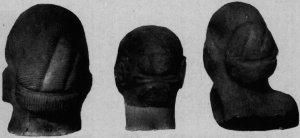Mesopotamian contacts: Double bun hair style
See Seals from Ur
See Seal from Mesopotamia with cuneiform inscription (the 'Rosetta stone' of the script)
   |
Side view and back view of three
steatite male heads showing hair-bun (Nos. 1 and 2 are casts), Mohenjodaro
See a woman's head in diorite found in Nin-Gal temple at Ur, ca. 2150 B.C.; note the engraved modulations of the hair, elaborate bun at the back of the head and the fillet around the forehead. |
 (Baghdad) (Baghdad)
|
Sumerian electrum helmet from
the Royal Cemetery at Ur; early Dynastic III Period, ca. 2400 B.C.; After Prichard 1969b:
49, no.160; Parpola, 1994, p. 254. This helmet was made of beaten gold, in the form of a
wig with a most elaborate hair-style. There is a knot of hair tied at the back, a twisted
plait and a headband, and there are guards for ears and cheeks. It belonged to
Mes-kalam-dug, the 'Hero of the Good Land'; he was perhaps a prince; a cylinder-seal with
his name was later found in a queen's grave. Gold dagger with lapis lazuli hilt and filigree sheath, Ur. Mes-kalam-dug's grave chamber had: a shield, two gold-mounted daggers, chisels and other tools, copper jugs, silver bowls and a set of arrows. He wore a broad silver belt from which hung a gold dagger and a whetstone of lapis lazuli. The coffin had been covered with a mass of beads of gold and semi-precious stones. Golden bowls were placed between the corpse's hands, near his feet elbow and behind his head, and by the right shoulder there was a double axe-head of electrum [We have elsewhere argued that electrum was called soma in the Rigveda.] |
 |
Harp-player of Sumer, from a plaque of Khafaje (After Heras, 1953, p. 182). |
| Seals with identical texts from
(a) Kish (IM 1822); cf. Mackay 1925 and (b) Mohenjodaro (M-228); cf. Parpola, 1994, p.
132. See Sign 311 of the script: |
|
 |
Clay tag from Umma, Iraq; seal impression on obverse; cloth impression on reverse (Ashmolean Museum, Oxford; cf. Parpola, 1994, p. 113). |
 |
Seal inscribed; Shortugai; Jarrige, 1984, Fig. 126 |
 |
The so-called 'royal standard'
from a tomb at Ur: a mosaic of shell figures on a background of lapis-lazuli; height 20
cm. The object is perhaps the sounding-box of a musical instrument. Side 1: victory celebration; the vanquished bring tribute, wild asses, bales of goods, meat and fish; the king wears his sheepskin shirt and sits on his throne; scenes of drinking and rejoicing; agricultural activity.[Note the one-horned bull and ibex] Side 2: top register shows prisoners being led before the king; some are naked, others wear kilts with a zig-zag hemline; the king stands on the ground, towering above the others (primus inter pares); top: infantry soldiers wearing helmets and stiff cloaks march to war with spears and battle-axes; bottom: a row of four war chariots going into battle; a leading chariot has its wheels rolling over bodies of fallen enemy soldiers; the charioteer and men with light spears ready to hand in quivers. |
|
|
||
| Advertise with us! |
|
|